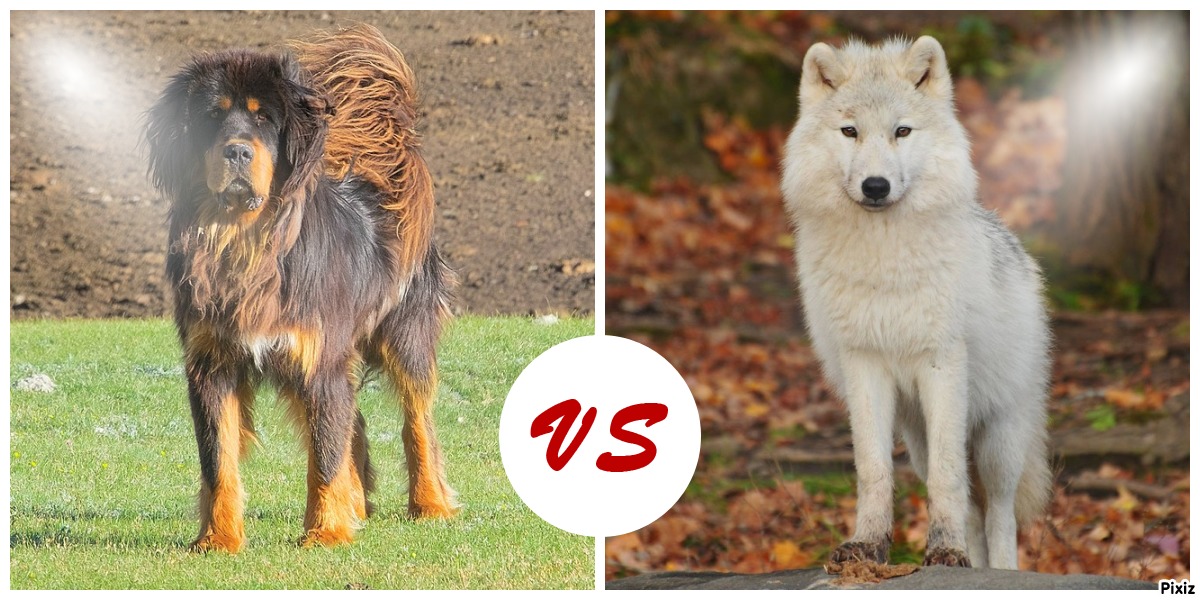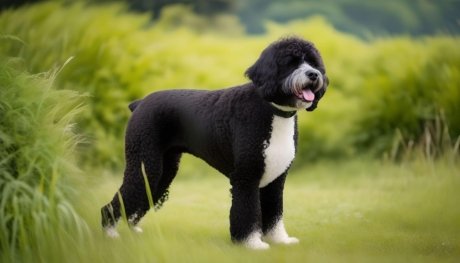Tibetan Mastiff Vs Wolf (2023) | Comparision & Differences
When it comes to formidable creatures in the animal kingdom, both the Tibetan Mastiff and the wolf command attention. These two fascinating creatures have captured the imagination of people for centuries. In this article, we will explore the characteristics, behaviour, and key differences between the Tibetan Mastiff and the wolf.
Tibetan Mastiff Vs Wolf
Key differences between Tibetan Mastiffs and wolves:
| Comparison | Tibetan Mastiff | Wolf |
|---|---|---|
| Species | Canis lupus familiaris | Canis lupus |
| Origin | Tibet | Various regions worldwide |
| Size | Large and powerful | Varies based on subspecies |
| Coat | Thick double coat, weather-resistant | Dense fur adapted to various climates |
| Temperament | Calm, protective, loyal | Highly social, pack-oriented |
| Hunting Style | Guardians, deter threats through presence | Skilled hunters, cooperative pack hunting |
| Social Structure | Independent, bond with human families | Pack hierarchy, alpha leaders |
| Adaptability | Well-adapted to harsh climates | Highly adaptable to diverse habitats |
| Predatory Behavior | Protective instincts, deter threats | Efficient hunters, prey on various animals |
| Interaction with Humans | Domesticated and bred as companions | Wild species, limited interaction with humans |
| Legal Ownership | Legal to own as pets in some countries | Generally illegal due to protection status |
1. The Tibetan Mastiff: A Majestic Guardian
History and Origins:
The Tibetan Mastiff has a rich history dating back thousands of years. Originating in the Tibetan Plateau, these dogs were bred to guard livestock and monasteries from predators. Their ancient lineage and majestic appearance have made them highly sought after around the world.
Physical Appearance:
Tibetan Mastiffs are known for their imposing stature. They are large and powerful dogs with a thick double coat, enabling them to withstand harsh weather conditions. Their expressive eyes and impressive manes give them an air of regality and nobility.
Temperament and Behavior:
Despite their size, Tibetan Mastiffs are generally calm and gentle. They possess a strong protective instinct and are fiercely loyal to their families. These dogs are known for their independence and self-reliance, making them natural guardians.
2. The Wolf: Nature’s Apex Predator
Species and Distribution:
Wolves are members of the Canidae family and are found across various regions of the world. They are highly adaptable creatures, with different subspecies occupying diverse habitats such as forests, tundra, and deserts.
Physical Characteristics:
Wolves are well-adapted for survival in the wild. They have a slender, muscular build with dense fur to endure cold climates. Their sharp teeth, powerful jaws, and keen senses make them efficient hunters and apex predators.

Pack Dynamics and Behavior:
Wolves are highly social animals, living and hunting in packs. They exhibit a complex social hierarchy and strong family bonds. Wolves communicate through vocalizations, body language, and scent marking, ensuring efficient coordination during hunting and territorial defense.
A Comparison of Traits
Size and Strength:
Tibetan Mastiffs are known for their impressive size, with males reaching heights of 26 inches and weighing up to 150 pounds. Wolves, on the other hand, vary in size depending on the subspecies but generally range between 24 to 36 inches in height and weigh between 60 to 120 pounds.
Adaptability:
Tibetan Mastiffs have been bred for centuries to thrive in the harsh Tibetan climate. They have a thick double coat and possess a natural ability to adapt to extreme temperatures. Wolves, with their exceptional adaptability, can be found in diverse habitats worldwide.
Hunting Abilities:
Tibetan Mastiffs were primarily bred as livestock guardians, while wolves are skilled hunters. Wolves possess a remarkable hunting prowess, capable of taking down large prey in coordinated group efforts. Tibetan Mastiffs rely more on their size and intimidating presence to deter potential threats.

Social Structure:
Tibetan Mastiffs are independent by nature and have a strong bond with their human families. They are not pack animals like wolves, who have a highly organized social structure with alpha leaders and intricate communication systems.
Interaction and Conflict
Historical Accounts:
Historically, there have been occasional encounters between Tibetan Mastiffs and wolves. In some cases, Tibetan Mastiffs were used to protect livestock from wolf predation. However, direct confrontations between the two species are relatively rare.
Territory Encroachment:
As human settlements expand and encroach upon natural habitats, conflicts between Tibetan Mastiffs and wolves can occur. The competition for territory and resources may lead to confrontations between the two species.

Predation and Defense Mechanisms:
While wolves are natural predators, Tibetan Mastiffs have a strong guarding instinct. When faced with a threat, Tibetan Mastiffs will utilize their size, strength, and powerful bark to deter intruders. Wolves, on the other hand, rely on their hunting skills and pack cooperation to secure their food sources.
The Role of Humans
Domestication of Tibetan Mastiffs:
Tibetan Mastiffs have been domesticated and selectively bred for their protective and loyal traits. Today, they are highly valued as companion animals and are known for their gentle and affectionate nature towards their families.

Conservation Efforts for Wolves:
Wolves, on the other hand, have faced numerous challenges due to habitat loss, hunting, and other human-related factors. Conservation organizations work to protect wolf populations and promote coexistence between humans and these magnificent creatures.
Conclusion:
In conclusion, both the Tibetan Mastiff and the wolf are awe-inspiring creatures, each with its unique characteristics and role in the natural world. The Tibetan Mastiff, a loyal guardian, exemplifies strength and nobility, while the wolf, nature’s apex predator, represents adaptability and pack dynamics. Understanding the differences between these remarkable creatures allows us to appreciate their significance and coexist harmoniously.
Frequently Asked Questions:
Can a Tibetan Mastiff defeat a wolf in a fight?
While Tibetan Mastiffs are powerful, a direct confrontation with a wolf is not advisable. Wolves are highly skilled hunters and possess natural advantages in such encounters.
Are Tibetan Mastiffs good family pets?
Yes, Tibetan Mastiff can make excellent family pets. They are loyal, and protective, and form strong bonds with their human families. However, proper training and socialization are crucial.
Do wolves attack humans?
Wolves generally avoid human interactions and rarely pose a threat. However, like any wild animal, if they feel threatened or cornered, they may defend themselves.
How fast can a wolf run?
Wolves can run at speeds of up to 35 miles per hour, allowing them to chase down their prey effectively.
Can Tibetan Mastiffs live in colder regions?
Yes, Tibetan Mastiff are well-suited for colder regions. Their thick double coat provides insulation and protects them from extreme temperatures.
What are the key differences between the Tibetan Mastiff and the wolf?
The key differences between the Tibetan Mastiff and the wolf lie in their domestication status, physical characteristics, hunting abilities, and social behaviour. While Tibetan Mastiffs are domesticated dogs known for their loyalty and protective nature, wolves are wild animals with complex social structures and strong hunting instincts.
Are Tibetan Mastiffs stronger than wolves?
Wolves are generally stronger than Tibetan Mastiffs in terms of physical strength and hunting capabilities. Wolves have evolved as apex predators with powerful jaws and muscular bodies, allowing them to take down large prey. Tibetan Mastiffs, although large and powerful, are primarily bred as guardian dogs rather than hunters.
Can Tibetan Mastiffs survive in the wild like wolves?
Tibetan Mastiffs, as domesticated dogs, are not typically suited for survival in the wild like wolves. They have been selectively bred over generations to serve as protective companions and guardians for humans. While they possess certain survival instincts, their dependence on human care and guidance sets them apart from the self-sufficient nature of wild wolves.
Do wolves pose a threat to Tibetan Mastiffs?
In general, wolves pose a potential threat to Tibetan Mastiffs, especially in areas where their territories overlap. Wolves, being natural predators, may see Tibetan Mastiffs as competition or a potential food source. It is important for Tibetan Mastiffs to have proper training and supervision when in wolf-inhabited regions.
How does the hunting strategy of a Tibetan Mastiff differ from that of a wolf?
Tibetan Mastiffs are not bred specifically for hunting purposes like wolves. Their role historically has been to guard livestock from predators rather than actively hunting prey. Tibetan Mastiffs rely more on their size, strength, and intimidating presence to deter potential threats, while wolves utilize their pack dynamics and hunting instincts to coordinate and capture prey.
Are Tibetan Mastiffs more suitable as guard dogs compared to wolves?
Tibetan Mastiffs are well-known for their natural guarding instincts and loyalty towards their families. They are often considered excellent guard dogs due to their protective nature and territorial behaviour. On the other hand, wolves are not suitable as guard dogs for human households as they are wild animals with different instincts and social structures.
What are the similarities and differences in the social behaviour of Tibetan Mastiffs and wolves?
Both Tibetan Mastiffs and wolves exhibit social behaviour but with significant differences. Tibetan Mastiffs are more independent by nature and form strong bonds with their human families. They are not pack animals. Wolves, on the other hand, live in organized social groups called packs, with a hierarchical structure and complex communication systems.
Can Tibetan Mastiffs and wolves coexist in the same habitat?
Tibetan Mastiffs and wolves can coexist in the same habitat under certain conditions. In areas where human settlements expand into natural habitats, conflicts between the two species may arise due to competition for territory and resources. However, with proper management and conservation efforts, it is possible for these two species to coexist harmoniously.
Are Tibetan Mastiffs more protective than wolves?
Tibetan Mastiffs are bred and valued for their protective instincts, making them highly devoted and loyal to their families. They are known to be vigilant guardians of their territory and loved ones. While wolves exhibit protective behaviour towards their pack members, their protective instincts are primarily focused on the survival and well-being of their own species.
What are the unique physical adaptations of wolves and Tibetan Mastiffs?
Wolves have evolved unique physical adaptations for survival in various habitats. They have sharp teeth and powerful jaws for hunting and consuming prey. Wolves also have excellent hearing and sense of smell, aiding in locating prey and communicating with pack members. Tibetan Mastiffs, on the other hand, have a thick double coat that protects them from harsh weather conditions. Their size and strength are notable physical attributes, contributing to their role as guardians.
How much does a Tibetan Mastiff cost?
The price of a Tibetan Mastiff can vary significantly depending on various factors such as lineage, bloodline, age, and breeder reputation. On average, Tibetan Mastiffs can range anywhere from $2,000 to $5,000.
Can you own a wolf as a pet, and how much does it cost?
In many places, owning a wolf as a pet is illegal due to the inherent challenges and risks associated with their wild nature. Wolves are highly regulated and protected species. However, some states or regions may allow private ownership under specific permits and strict regulations. The cost of obtaining a legal wolf hybrid can range from $1,000 to $3,000, but the expenses for their care, specialized facilities, and legal requirements can be significant and should be carefully considered before pursuing ownership.
How much does a Tibetan Mastiff cost in India?
The price of a Tibetan Mastiff in India can vary depending on factors such as lineage, quality, and breeder reputation. On average, Tibetan Mastiffs in India can range from ₹1,00,000 to ₹5,00,000.
Can you legally own a wolf as a pet in India, and what is the cost?
In India, owning a wolf as a pet is generally not allowed as they are protected under the Wildlife Protection Act, 1972. Wolves are considered wildlife and cannot be kept as pets without specific permissions from the relevant authorities. The cost of obtaining a legal permit and keeping a wolf as a pet in India is not applicable due to the legal restrictions in place.
Recommended related to Tibetan Mastiff Vs Wolf:
Golden Retriever Vs German Shepherd – (2023) – Comparision
Akita Vs Shiba Inu (2023) | Comparision between Two Popular Dog Breeds





























